Ready to take the next step?
The Activity Ladder – Pipeline Management from prospecting to purchase
The Activity Ladder is a commonly used model for structuring your sales process in a linear way. With every interaction, your goal is to climb one step higher, all while building trust and gaining a deeper understanding of your customer.
This ladder represents your pipeline—each step you need to take to turn a prospect into a customer.
The first step is identifying the right customers—a phase often referred to as prospecting in sales. Here, it’s all about finding your ideal customer whose needs align with what you’re offering.
Each step on the ladder brings you closer to closing the deal, making it a vital tool for a well-structured and effective sales process.

7 steps to a winning sales process
What steps are included in your sales cycle?
Every business is unique, and so are their sales processes. To take the first step toward a structured sales process, you need to clarify the steps in your sales cycle, from prospecting to closing. Reflect on your sales activities and create your own activity ladder. For example, do you need two customer visits to close a deal? Could it be streamlined to just one instead? Once you’ve identified the steps, it’s time to start measuring your hit rate.
With a CRM system, you can easily map and structure your entire sales process, from the first contact to the closed deal.
What’s your hit rate, and what’s the average deal value?
Selling without knowing your hit rate is like fishing without bait—you’re hoping for a miracle. To succeed in sales, you need to know what works. Your hit rate shows how many proposals lead to closed deals and how much time you spend creating them.
How often do you progress in your sales cycle? Calculate the percentage for each step:
- How many prospecting efforts lead to a meeting?
- How many meetings lead to a sales call?
- How many sales calls lead to a proposal?
Example: If four prospecting efforts lead to one meeting, your hit rate is 25%.
A CRM system makes it easy to calculate this and helps you maximize your sales.
Calculate the average value of your closed deals:
Divide your total sales revenue by the number of closed deals over the past 12 months:
Example: 2,472,500 SEK (total sales) / 215 (deals) = 11,500 SEK per deal.
It’s that simple! Now you know your hit rate and average deal value. Lime Go also makes it super easy to visualize these key metrics.
What do you need to do to reach your sales goal?
Step three in a winning sales process: Break down your goals and activities into months, weeks, and days. How many activities are required to meet your goal? Use your sales goal and average deal value:
Example: Annual goal: 1.5M SEK. Average deal value: 75,000 SEK.
In this example, you’d need to close 20 deals in a year to reach your sales goal (75,000 x 20 = 1,500,000).
Use your hit rate to determine what you need to do
Let’s say you have a hit rate of 50% between each step in the activity ladder. Closing 20 deals would therefore require 40 proposals. Over an entire year, this translates to 80 follow-up visits, 160 first-time visits, 320 calls to book meetings, and 640 contacts with potential customers. You can quickly see that you need to keep the momentum going if you want to reach your goal, right?
Your new schedule for the week
Let’s simplify the numbers. With 40 workweeks in a year, your weekly targets become clear for reaching 1.5 million SEK in sales:
- 1 proposal
- 2 follow-up meetings
- 4 first-time meetings
- 8 calls to book meetings
- 16 new prospects
Breaking down the goals makes it easier to focus on value-creating activities that drive sales forward. With a structured sales process, you’ll always know what it takes to achieve your goals.
Prospecting: How to find the right customers
What value does your business create for the customer? As an experienced salesperson, you probably already have this figured out, but if you’re unsure—find out. Smart prospecting will save you a lot of time, and it begins with understanding who your ideal customer is. Your ideal customer is the group most likely to lead to a deal, where your offer aligns perfectly with their needs.
Many companies divide their prospecting lists by industry or number of employees. But just because two customers are in the same industry doesn’t mean they need the same thing. With Lime Go, you can segment smarter and find customers that truly fit your business. Additionally, you can leverage updated data from Dun & Bradstreet to always work with the most current figures.
Lime Go
A plug-and-play CRM for growing B2B companies or sales teams, with the option to integrate with ERP systems for a complete overview. Perfect for those who want a smart CRM to manage the entire sales process more efficiently.
- Integrated company data for well-informed decisions
- User-friendly system
- Organized data and processes
- Smart and efficient prospecting
- Proactive sales for faster deal closures
Booking meetings: Build trust that captures the customer’s heart
Credibility, timing, and engagement! Your first contact should capture the customer’s heart, and you only have a few seconds to make it happen. This step demands a certain level of commitment from you as a salesperson to succeed. A great salesperson is also a great listener. By mirroring the customer’s language and energy, you increase your chances of having a meaningful conversation.
With Lime Go, you can gather relevant customer information even before your first call. Using the system’s efficient search functions and infotiles, you’ll be better prepared and able to craft a conversation that truly hits the mark.
Cold calling can be a challenging process. Often, you’re trying to spark interest in someone who doesn’t know you or your company. Simply reading from a sales script doesn’t cut it anymore. Instead, think of the customer as a new friend: What is this person interested in? By showing genuine interest in the customer, you build stronger relationships and increase your chances of booking a meeting.
The right research makes your sales meeting a success
Building long-term relationships requires trust. The best salespeople understand their customers’ challenges and build confidence by showing they care. Take a closer look at what’s happening in your customer’s organization, especially if they seem busy. Review the notes from your initial meeting:
- What does the customer need?
- What challenges are they facing, and how can you solve them?
- What terms and expressions does the customer use?
Immerse yourself in the customer’s world and demonstrate how your solution can address their challenges. Make your offer the answer to their biggest headaches.
Wrap it up with a personalized quote that seals the deal
Some B2B sales processes are lengthy and can take years to close. Patience is key to keeping the customer engaged over time without coming across as pushy. It’s easy to focus more on your product as you approach the top of the activity ladder, but try to avoid this! Instead, listen to the customer and provide encouraging solutions. If the customer feels your solution addresses their needs, closing the deal becomes much easier.
Sometimes, customers may need incentives during the sales cycle to make a decision. In these cases, a special offer or discount can be helpful when presenting your quote.
Also, consider the quote’s format, how it’s delivered to the customer, and how it can be signed (e-signatures are highly recommended as they’re the fastest option). These details influence how easy it is for the customer to approve the quote and finalize the deal. With a clear layout and smooth signing process, closing the deal becomes a breeze!
The right CRM for your digital sales process
Sales processes come in all shapes and sizes, and it’s possible to maintain a structured approach even without a CRM system. However, with a CRM system like Lime Go, you gain a tailored tool that makes your work much more efficient.
Answer the following questions to see if Lime Go is the right fit for you:
- Do you want to simplify prospecting with suggestions for customers that match your business?
- Do you need an easy way to track your monthly quote value?
- Do you want to avoid manually entering company information and updating customer profiles?
All this is possible with Lime Go. And the best part? It doesn’t have to break the bank!
We at Lime are a Nordic CRM provider with over 30 years of industry experience. Try Lime Go today!
What are you waiting for?
There’s no time to waste! Let’s find the solution that will help you get more customers and turn existing ones into loyal ambassadors today.
